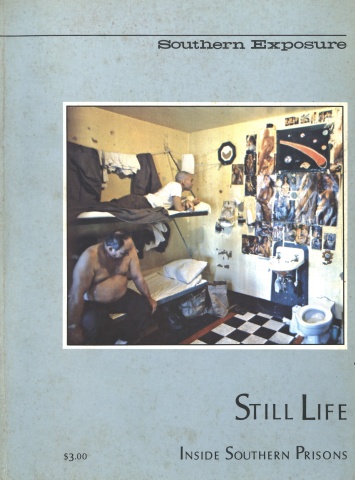
This article originally appeared in Southern Exposure Vol. 6 No. 4, "Still Life: Inside Southern Prisons." Find more from that issue here.
*Information on crime and punishment in these countries was supplied by Polly Smith and Becki Ney, Assistant to the Director and Research Assistant, respectively, at the American Foundation.
HOLLAND
The philosophy that prisons are harmful institutions and should not be heavily relied upon pervades the procedures and practices of the Dutch criminal justice system. From the police to prison, the system is aimed at minimizing the number of people who become further involved in the justice system and ultimately reach prison. As a result, Holland has the lowest incarceration rate — 24 prisoners per 100,000 inhabitants — of all industrialized Western nations, a rate one-tenth that of the United States, although Holland’s rate of serious crimes is only half that of our country.
The Dutch keep few people in jail for several reasons. First, no official in its crime control system has to campaign for office. Thus, the business of “repression,” as the Dutch police so candidly call it, is not highly politicized. Lawyers, judges and other functionaries deal only with the most serious crimes, leaving others to be resolved by social service agencies, churches and other community controls. Then, of those people slapped into jail, only about four percent are sentenced to terms longer than one year; the average sentence comes to about three months. Finally, if there is no room in prison, the prospective prisoner will simply “take a ticket” to report later.
One Dutch prosecutor recently told a group of American corrections specialists, “Almost everyone in Holland knows that prison has mainly, or only, negative effects. Some may think it is necessary, but they too know it is negative.” An offical spokesperson for the Dutch Ministry of Justice concurred, saying, “It is almost hypocritical to think a person in prison can be made better... so we try to limit the damage.”
All procedures in the Dutch justice system are expected to comply with the “subsidiary principle.” This means that criminal proceedings and sentencing should only be used when it is clear such a disposition is more effective than a noncriminal process or a less severe sentencing option. In support of this principle, the police are encouraged by the prosecutors and Ministry of Justice to arrange fines at the site of most crimes or negotiate a settlement between involved parties. Only prosecutors are authorized to bring a criminal charge into court. Therefore, they must decide which cases they or another agency can resolve to the satisfaction of the parties involved. Because prosecutors adhere to the subsidiary principle, more than half the cases referred to them are screened away from the court, regardless of the likelihood that the accused will be found guilty. Judges play their part by heavy use of fines, even in serious property or person offenses. In 1975 (latest figures), almost two out of every three convictions for serious crimes resulted in impositions of fines.
The Dutch use prisons more to mark the limits of social tolerance than as incapacitation or deterrence. Because most Dutch officials say it cannot be proven that prisons protect the public in the long run or that prisons improve the people placed inside, they choose to incarcerate as few offenders as possible for as short a time as possible. In 1975, for example, out of 14,474 Dutch prison sentences, three-quarters were imprisoned for three months or less. Only about five percent are serving terms longer than a year; average time served in American state prisons is over one year. In Holland, a prison bed must be vacant before a convict is imprisoned. To accommodate everyone, the Ministry of Justice has developed a practice called “walking convicts,” which grants at least a four week delay between the time of sentencing and imprisonment. Consequently, the Ministry develops a waiting list to regulate the flow of people into the prisons. Some people argue that the “walking convicts” practice shows that these offenders need not go to prison at all because they can be punished in less costly, less destructive ways without threatening public safety. Whether or not this argument is accepted, the practice functions in a useful, immediate way to relieve or prevent overcrowding.
In conclusion, the Dutch have developed procedures through their justice system consistent with their often repeated assertion that prisons are harmful institutions, to be used sparingly and as a last resort.
DENMARK
Ringe, Denmark’s experimental prison, was built on the principle that “the purpose of imprisonment is punishment, but the loss of liberty should be the only punishment.” Built in 1973, Ringe differs from most prisons in Denmark in that it is a maximum security institution with a wall around it. However, while Ringe is one of Denmark’s most secure prisons, it is quite relaxed on the inside.
The 50 inmates, 40 men and 10 women, live together in housing units of 16. Men and women work together and have rooms side-by-side in the housing units. They must buy and cook their own food, work a full week (for which they are paid between $17 and $43) and manage their own money. Not only do these arrangements create an atmosphere much like the real world, but they demand that prisoners take considerable responsibility for their own lives.
There are no guards at Ringe in the traditional sense. “Standard officers” of both sexes were hired to fulfill the duties of work supervisors, social worker and guard. All of them are carpenters because the major occupation of the inmates is work in the prison’s furniture factory. Only a few guards had had previous correctional experience. This break from tradition, both in roles and in qualifications for employment, has opened communication between prisoners and guards that usually eludes those behind bars.
The Ringe experiment is too new for anyone to predict how it will affect inmates after release. But the Ringe prison at least proves it is possible to combine the temporary deprivation of a convict’s freedom with the recognition and maintenance of many individual rights and responsibilities.
ENGLAND
In England, judges may use “community service orders” as an alternative to sending a person to prison. These court orders require the offender to work a certain number of hours without pay in the service of the community. Public and private (non-profit) organizations may use community service workers, and those administering the programs may form work groups to do special projects for members of the community.
Faced with crowded prisons and dissatisfied with the costs of imprisonment, the English Parliament established this sentencing option in the 1972 Criminal Justice Act. The Act applied initially to six court jurisdictions. After several years of positive experience, it was extended to the whole country. This legislation authorizes magistrates, the British equivalent to our county court judges, to use community service sentences only in cases for which a prison sentence is being considered. The law also stipulates that sentences may range from 40 to 240 hours but must be completed within one year.
Work assignments now include making equipment for youth clubs, clearing walks in parks, renovating community centers, gardening for senior citizens and establishing adventure playgrounds with recylced materials. The best placements are those in which the offenders have an opportunity to experience directly the impact of their help upon the problems of others. Community service is a punishment because offenders lose their leisure time, but the type of work done is not meant to be distasteful.
Most community service participants, like most people in prison, are between the ages of 18 and 25. Community service was first used as an alternative for petty offenders, but the nature of the crime is no longer a principal criterion for acceptance into the program. People guilty of violent offenses or with prior records have been accepted and successfully placed.
While national statistics are unavailable, the 1977 annual report of the Inner London Community Service Program claims that a total of 1,787 offenders serving 130,000 hours have been handled by the program from 1973 to 1976. The satisfactory completion rate for these years was just over 70 percent. Another program in Nottinghamshire reported a similar success rate in 1975. Criminal justice system officials estimate that 60 percent of those participating would otherwise have been incarcerated.
The responses of the judges, probation personnel, participants, service agencies, media and English public have been overwhelmingly supportive. Some volunteers have continued their service work beyond the required hours, either in paid or volunteer status. Program staffs are now resisting pressure to expand the use of community service for those failing to pay fines. Such an expansion would dilute the present thinking that community service is a substantial punishment which can substitute for imprisonment.
Tags
Southern Exposure
Southern Exposure is a journal that was produced by the Institute for Southern Studies, publisher of Facing South, from 1973 until 2011. It covered a broad range of political and cultural issues in the region, with a special emphasis on investigative journalism and oral history.


